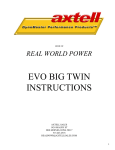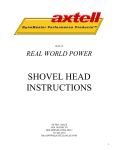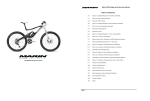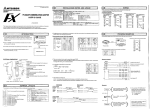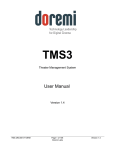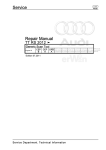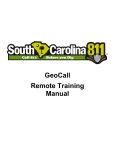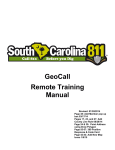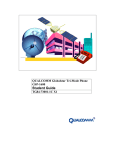Download Catalog
Transcript
00 HOME OF REAL WORLD POWER TWIN CAM INSTRUCTIONS 1 AXTELL SALES 1424 MAURY ST DES MOINES, IOWA 50317 515.243.2518 [email protected] 1 Congratulations on making a wise investment in your bike’s future. Our Axtell Sales cylinder kits have a proven track record for high performance, quality workmanship, and relentless dedication to customer service. This instruction manual should facilitate the installation of the kit and have you back on the road producing Real World Power. SECTION 1 Axtell Sales Company Policy SECTION 2 Things to Remember SECTION 3 Machining SECTION 4 Specifications SECTION 5 Installation SECTION 6 Before Riding SECTION 7 Further Information Please read instructions thoroughly before beginning your installation. If you still have questions regarding your install after reading this manual, please contact our tech line at 1.515.243.6069 .axtellsales.com for product, service and Also, make sure to check out our web site at www www.axtellsales.com news updates. LAST REV. 06/04 2 22 Axtell Sales Company Policy Disclaimer All Axtell Sales products are intended for of offf road use only only.. The words Harley Davidson™, EVO™, XL™, Evolution™, Sportster™, Big Twin™, Twin Cam™, Shovelhead™, and Panhead™ are used as a reference only and are not intended to imply that these parts are manufactured or endorsed by Harley Davidson Motor Company. It is the responsibility of the user to determine if any products sold by Axtell Sales are appropriate for their desired application. The user will assume any and all legal and personal injury risk and liability, and all other obligations, duties, and risks associated with the installation of these parts. Limited Warranty All of Axtell Sales, Inc. products are to be manufactured free from defects in material and workmanship at the time of manufacture. It is the responsibility of the purchaser to inspect all goods carefully before use. Any returns are to be made before the product is installed or modified in any way. Credit, repair, or replacement of goods is predicated upon factory inspection. Axtell Sales Inc. is not responsible for improper installation of or damage due to abuse (including competitive racing, dynoing, etc.) or improper lubrication. (For warranty claims on items not manufactured by Axtell Sales please refer to original manufacturer.) Returns Any merchandise that appears to be damaged in shipping must be reported immediately. Do not send parts back. All returns or exchanges must be made before use and within 30 days of purchase. Call or write for authorization before returning any merchandise. Returns must be shipped in original boxes and accompanied by a copy of the original invoice. All return freight will be paid by the returnee. Returns for any reason other than defective merchandise are subject to a 15% restocking fee. There are no refunds on any custom order parts. Payment Terms A 50% deposit is required on all custom-made cylinder orders. We require advance wire transfer payment on all foreign accounts. Payments may also be made using Visa, Master Card, Discover, or American Express. Shipping All orders will be shipped United Parcel Service C.O.D. unless other arrangements have been made in advance. A service charge of $5.00 will be added to all orders less than $25.00; this charge may be waived for customers whose volume warrants occasional small orders without penalty. Any customer 1that refuses any order will be required to post a $25.00 shipping bond on their next order. Prices All listed catalog prices are suggested retail and are subject to change without notice. 22 3 Things to Remember Instructions in this manual are intended to be used in conjunction with the service manual corresponding to your bike. Don’t have one? Go to your local Harley dealership and get one. You’ll wonder how you ever got along without it. INSTALLING PAR ARTS THINGS TO REMEMBER WHEN INST ALLING ENGINE P AR TS Work Clean Nothing can damage your vital engine parts like dirt. Foreign debris (dirt, filings, etc.) in your bike’s engine can cause premature failure by scratching your cylinder walls, piston skirts, and obstructing vital oil passages, just to name a few. Make sure to work in a clean environment with clean tools. A clean, well-built motor will last you for years. Beware of any obstructions in your motor. Any sharp edges on your kit should be addressed. Sharp edges can produce detonation in the combustion chamber or scuffing of the piston skirt. Both lead to premature engine failure. When removing edges, use a good hand file, not an abrasive wheel. Wheels imbed grit into the metal, drastically shortening your engine’s life. Work Smart Always use good judgment when installing our cylinder kits. A hastily built motor will not last as long as one that is put together with care. A good, clear head is absolutely necessary during installation. Make sure to double-, and maybe even triple-, check your work. You may be itchin’ to ride, but you would sure wish you would have taken your time when your motor’s life is cut short due to misinstallation. Not only are you out the riding time, but also the money to cover the repairs. Building motors is a science. Our specifications are the result of many years of testing. Some builders may find they prefer a different method of installation, which is fine if it works for them. But for us, as well as many of our satisfied customers, these specs have proven themselves to provide big power and many years of engine longevity. 44 4 Machining Axtell Sales offers custom machining as a service to all of our customers. If interested, please call, e-mail, or visit www.axtellsales.com for rates. Machining is necessary for all of our big bore kits. These include all Twin Cam kits with a cylinder bore 4” or larger (numbers listed above). This boring to the crankcases is necessary so the big bore cylinders will properly fit into the spigot holes. While machining, the top case bolt will be cut into by the boring fixture. As a result, the bolt will experience a loss in tensile strength, resulting in possible leaks, and perhaps damage to your cylinders/ pistons. Axtell Center bolt Instructions 1. On a drill press or mill, using a #10 drill (.1935”), drill through the right side case half top center bolt hole. 2. From the outside surface of the case, spot face the bolt hole to 1/2”, to ensure a flat surface for the flat washer. 3. Assemble cases using the stock case bolts. Use Axtell p/n 000-220A Big Bore Center Case Stud Kit with 10-24 x 4-3/4”stud, sleeve, flat washers and nylock nuts in place of the top center bolt. Install 10-24 stud from the cam side of the case. Torque stock case bolts according to the Service Manual. Center the stud in the case, install sleeve, flat washers and locknuts, torque to 45 in/lbs. 4. Bore case as per cylinder manufacturer’s instructions. After completing this operation, install the case assembly into a mill or boring bar. Bore out the 1 spigot holes to accept the new cylinders. All cases will need to be bored to 1.625” deep. Be careful not to exceed this distance, as you stand a great chance of cutting into vital oil passages. For our Twin Cam cylinder kits with a 4” piston, bore cases 4.210-4.215” X 1.625”. For Twin Cam kits with 4-1/8 (4.125)” pistons, bore cases 4.310-4.315” X 1.625”. Then step bore the cases from 1.625” deep at 4.160 dia x .250” deep. 5 Specifications There are a few things that every engine builder should know about our products and how to use them. Following are several key specifications that Axtell adheres to. The installation section of this manual will make reference to these specs, so be familiar with them and keep them handy for reference. PIST ON CLEARANCE PISTON The Axtell line of pistons uses a modified barrel shape that should be measured .500” up from the bottom of an un-clearanced piston. Measure the pistons and add the desired running clearance to determine the finished bore size. Piston skirt-----4.1230 +0.0025 Clearance----Clearance-----+0.0025 Finished bore--4.1255 There is a lot of confusion on how to determine the piston size on an engine that has the intake side of the rear piston notched. We at Axtell recommend taking the uncut piston in the kit and measuring it directly under the oil ring. Then, measure the cut piston directly under the oil ring and verify that the two pistons are the same size. Then, use the uncut piston at the normal checking point of .500” up and set both cylinders to this dimension. Using this method will ensure that the critical piston clearances (under the oil ring and ring lands) will have enough clearance. Axtell recommends .002-.003” piston to cylinder clearance when installed in aluminum cylinders. Cast iron cylinders will need .0025-.0035” clearance for optimal ring seal at operating temperatures. If you are going to modify your pistons, the skirt and wristpin bore dimensions can change. It is advisable to measure the pistons before any work is done to it and then re-verify the measurements after machining. PIST ON RINGS PISTON When installing rings, use extreme care. Overextension will impose stress points on the ring and may eventually cause piston damage. Top rings: Most of the top rings used in our sets are a moly faced type. Moly is a lighter colored metal on the face of the ring. It may have a “pip” mark or dot on the side and, if it does, it should be installed up. If there is no pip mark, look for a bevel cut along the inner edge. It should installed with the bevel up. If no bevel or pip is present, it can be installed either side up. Bottom Compression Rings: This ring usually has a slight bevel on the inner edge and it should be installed with the bevel DOWN. 6 66 66 Oil Rings: These are a 3-piece design with one expander and two rails. Rails can be ground to set the end gap but the expander should not overlap or be modified in any way. Ring end gap logic: In a running engine, the actual ring end gap is a combination of the expansion rate of the ring itself and the expansion rate of the cylinder bore. We have tested and seen a stock OEM aluminum cylinder grow over .009” at operating temperature. This cylinder bore expansion adds greatly to your ring end gap (.009 X Pi = .028+)! When using an aluminum cylinder, you can set the end gap at the minimum figures shown below. When using our Axtell cast iron or ductile cylinders, the growth is MUCH less and the ring end gap should be opened up to the larger figures. This larger end gap should not be of concern when one realizes that the end gap closes up considerably when the engine reaches operating temperatures. Minimum end gap recommendations: Top rings: Use 4 thousandths per inch of bore in aluminum cylinders. Example: 4” bore is 4” X .004” = .016” end gap Use 6 thousandths in cast iron or ductile iron cylinders. Example: 4” bore is 4” X .006” = .024” end gap Note: Restrictive or long exhaust systems really add to engine heat and the end gap should be pushed up to the high end of the scale to accommodate for expansion. 2nd Rings: Use 4 to 5 thousandths per inch of bore for all types of Axtell cylinders. Example: 4” bore is 4” X .004-.005”= .016-.020” end gap These rings are not exposed to nearly as much combustion chamber heat, so it isn’t necessary to accommodate for as much expansion. Oil Rings: A 3-piece oil ring works because the expander butts together after the rails are installed and the ring assembly is inserted into the bore. The corrugated expander supplies the tension while the rails scrape the oil off of the cylinder wall. The rails should have between .015” and .050” end gap. The expander should not be modified in any way. You will need to adjust ring end gap by grinding or filing. Always work from the outside of the ring face inward when machining the ring. If the ring is filed or ground from the inside out, you stand a good chance of chipping the ring face which will cause engine damage while running. Remove burrs from rings after grinding or filing, then thoroughly clean. 1 Note: When building an engine, we recommend checking the oil tension before final assembly. We install the oil ring only on the piston and insert it into a lightly oiled cylinder. We then measure the amount of drag generated by the ring tension. You can use a quality fish scale or digital scale to measure the pressure needed to move the piston and ring assembly through the bore range at a steady speed. We have been able to maintain oil control all the way from 9 pounds on a maximum output engine to 27 pounds for a high mileage touring application. 7 WRISTPIN KEEPERS & TEFLON BUTT ONS BUTTONS Axtell uses two types of wristpin keepers; .073” wire and Spiro locks. The wire lock has a groove that is round on the bottom and has a notch cut in the piston to aid in removal. The Spiro lock has a conventional square bottom groove and no notch. A few Axtell pistons are set up for double Spiro locks and the grooves are twice as wide (.088” vs. .044”). Our fully skirted pistons are designed to use teflon buttons as opposed to keepers. We make them in various depths to achieve proper wrist pin endplay. Subtract the pin length, combined with 2 buttons, from the bore to determine endplay. Axtell recommends .020-.060” end play. BORE & HONE INSTRUCTIONS When reconditioning a set of used cylinders, we highly recommend facing the head and base gasket surfaces as the first step. This removes any warping and gives a good “datum” point for all following machining steps. We also recommend boring all cylinders to ensure the bore is perpendicular to the base gasket area. When you hone a cylinder, you can get it round but not necessarily straight. When boring, we recommend leaving .008-.009 for honing. This much material will ensure that each honing step has the chance to do its job. Use torque plates designed for your cylinder bore when honing (do not use 3 13/16 plates on a 3 1/2 bore cylinder). We use stones in 5 steps of grit: 70; 180; 220; 280 and a cork wiper finish. We offer cylinder reconditioning as a service to our customers. With our experience and large library of torque plates and pistons, we usually save you both time and money. BALANCE FL YWHEELS FLYWHEELS All engine builders have a preference on the type of balancing. It is your choice, we would simply like to remind you that balancing is necessary when changing piston weight. Here at Axtell, we static balance using a 60% balance factor. OTHER CONSIDERA TIONS CONSIDERATIONS When installing pistons, it is absolutely vital to maintain proper clearance between your pistons. We recommend a clearance of at least .060” between the pistons at their closest point; usually, but not always, BDC. We only machine the rear piston so as to avoid cutting piston skirt off the thrust side of the front piston. It is also important to maintain a proper distance between the valves and the piston. A minimum of .060” for intake valve and .090” exhaust valve clearance is desired. One remaining measurement that we find especially helpful is the deck height. A compression squish of .030-.050” is recommended for optimal performance. You need to measure your deck height and adjust accordingly. In addition to these measurements, make sure that your kit is well lubricated while installing. The assembly must be well oiled to cushion the parts until the oil pump catches up. 88 8 Installation Installation of our Twin Cam cylinder kits is an easy way to increase power and performance. Assembly requires no more know-how than a stock H-D engine. These instructions are designed to aid in the installation process to get you back on the road producing street, race, and dyno proven power. These instructions make continuous reference to an H-D Twin Cam service manual. All Axtell cylinder kits use the same specifications and assembly order as a stock Twin Cam motor. You will want to have a manual handy for reference. These manuals will not only give you specifications exclusive to your motor, but mountains of other helpful information. It will also help to avoid the confusion associated with sorting through numbers to find the ones you want. You may also find it useful to refer to the specifications portions of this manual. Disassembly To begin, you will need to disassemble the top end of your engine. Refer to the DISASSEMBLE section of your manual. For drop on kits (P/N’s 200-120, 200-160, 200-161), you will need to go only as far as removing the cylinders and pistons. If you have purchased a big bore kit, you will need to continue disassembling until you have completely removed the engine and removed the flywheels from the cases. Before Reassembly If you have a big bore kit, you will need to refer to the machining section of this manual before continuing. After completing the machining and cleaning, reinstall the flywheels into the cases and continue following the engine assembly section of your manual. All cylinders have been coated to protect and prevent rust. This coating will need to be removed before using them. You will need to have a relatively firm bristled plastic brush. Brush with hot soapy water until clean. Rinse out the cylinders and dry completely. Oil the inside of the cylinders with a white paper towel. If the towel is dirty after wiping, your cylinders are not clean enough. Brush again with hot soapy water. Continue in this fashion until towel remains clean when oiling cylinder. At Axtell, we make necessary clearance determinations now before beginning the final assembly. Mock-up the piston and cylinder assemblies. Take note that the notched piston is installed in the rear cylinder with the notch facing forward. The bottoms of each cylinder have been stamped “F” for front and “R” for rear. Raise the cylinders above the case so you have enough room to see the bottom of the pistons. Roll the motor over until the pistons are at their closest point (not necessarily BDC). 1 There needs to be at least .060” clearance between them. Now, slide the cylinders down until they are seated. Check the deck clearances at TDC and make changes to your squish accordingly. You will also need to install the lifter covers to check the clearance between the covers and the cylinders. If additional clearance is needed, the cover can be ground or sanded. 88 Note: Additional clearances may be found in the specification section of this manual. 9 Reassembly Once you are satisfied with your clearances and have made the necessary changes, you may begin reassembling your motor. Refer to H-D manual. You will want to liberally coat all moving parts with high quality oil to avoid breakdown upon startup. Installation follows the H-D manual exactly, with the following exceptions. Note these exceptions before beginning install. If you have machined your top case bolt, make sure that the bolt is correctly positioned (“clocked”) through the case so as not to obstruct cylinder spigots. If the top case bolt is turned after assembly, the bolt will distort the spigots, creating an extreme hazard to the piston and case assembly. The drop-on kits (P/N’s 200-120, 200-160, 200-161) have been supplied with a special base gasket that is meant to be used with the stock o-rings. Install the gasket to the cylinder, followed by the o-ring. Dowel pin o-rings may also be used. However, the big bore kits (P/N’s 200-200, 200-215, 200-300, 200-315, 200-320, 200-321, 200-330, 200-331) will not accept the factory o-ring under the base gasket. They will still use the dowel pin o-rings. If Axtell has supplied you with a 3-piece head gasket that has been riveted together, and you find that the rivets will be pinched when installing the head, they will need to removed, but do not change gasket configuration. If the rivets pose no clearance problem, they may be left on the gasket. 10 10 1010 Before Riding As a result of increasing your horsepower, whether it is bore, stroke, or a gain in airflow, you must supply the motor with more fuel. Too lean of a fuel mixture is dangerous because it burns more slowly, and requires more time to conduct the heat from the combustion. These are air-cooled engines and they are not nearly as forgiving as water-cooled automobile engines. TUNING Before Riding If ever in doubt about proper jetting, always enrich in large increments. If the engine is running on a lean mixture, the temperature in your combustion chamber will rise, causing detonation (knock) or pre-ignition, which is an uncontrolled burning of fuel. Pay special attention to low speed jets, as they will control fuel mixture at idle. Changing the main jets will help at highway speed, but will not help result ofduring increasing horsepower, whether it is bore, stroke, or a gain in airflow, you control As fuela mixture targetyour break-in rpm range. must supply theismotor with more fuel. Tooinlean a fuel mixture is dangerous because it burns Timing another important factor heatof buildup. Too advanced of a spark will also causemore heat slowly, and requires morepoint timeisto32° conduct the heat from the combustion. These are air-cooled engines build-up. A safe starting full advanced. and theyThe arefirst not few nearly as forgiving as water-cooled automobile moments of a motor’s life are the most crucial.engines. Take care to make the aforementioned changes before breaking motor in. Also, make sure to verify that there is proper oil pressure on startup. For these Twin Cam kits, you need to have at least 20 psi pressure at normal operating temperature at 3000 rpm. TUNING CARBS: If ever everinindoubt doubtabout aboutproper proper jetting, always enrich in large increments. the engine is running If jetting, always enrich in large increments. If the If engine is running on a on amixture, lean mixture, the temperature your combustion will rise,detonation causing detonation (knock) or lean the temperature in your in combustion chamber chamber will rise, causing (knock) or pre-ignition, pre-ignition, which is an uncontrolled burning ofattention fuel. Paytospecial attention low speed jets, asmixture they which is an uncontrolled burning of fuel. Pay special low speed jets, as to they will control fuel Breaking in your motor is vital to the life of your engine. Axtell’s recommended method of will control fuelAmixture at idle. Changing main jets will at highway willbreak-in not help at cruise RPMS. larger main jet will help at ¾the to full throttle but help will not be in playspeed, duringbut target rpm break-in is to heat cycle the motor. Start the motor (with plenty of air blowing over the motor to dissipate ranges. control fuel mixture during target break-in rpm range. BREAK-IN heat) and allow it to run for thirty seconds. Allow the motor to completely cool to room temperature. Timing is another important factor in heat buildup. Too advanced of a spark will also cause heat Once cooled, start the again and allow it to run for sixty seconds followed by a complete cool FUEL INJECTION : motor build-up. A safe starting point is 32° full advanced. this process, thirty seconds each time until you reached four when minutes. down. Repeat Air of 14.6adding are for very light cruise areas buthave are much too the lean you ask the TheFuel firstratios few moments ofOK a motor’s life arethrottle the most crucial. Take care to make aforementioned Now thereal vital break-in is done. However, over theWILL coursedamage of the next thousand miles, the internal engine to do any work. 14.6 and retarded ignition timing your cylinders, pistons and rings! changes before breaking motor in. Also, make sure to verify that there is proper oil pressure on startup. This old fact remains If you are going to makewith real one horsepower lots care of airduring and lotsthat of fuel. components are stilltrue: familiarizing themselves another,you so will takeneed special time. For these Twin Cam kits, you need to have at least 20 psi pressure at normal operating temperature at Keep your engine under 3500 RPM’s for the first 300 miles, and less than 4000 RPM’s for the first 1000 3000 rpm. miles. Do not put a large load on the engine and be careful not to “lug” the engine during the 1000-mile break in period. BREAK-IN 1 Breaking in your motor is vital to the life of your engine. Axtell’s recommended method of break-in is to heat cycle the motor. Start the motor (with plenty of air blowing over the motor to dissipate heat) and allow it to run for thirty seconds. Allow the motor to completely cool to room temperature. Once cooled, start the motor again and allow it to run for sixty seconds followed by a complete cool down. Repeat this process, adding thirty seconds each time until you have reached four minutes. Now the vital break-in is done. However, over the course of the next thousand miles, the internal components are still familiarizing themselves with one another, so take special care during that time. Keep your engine under 3500 RPM’s for the first 300 miles, and less than 4000 RPM’s for the first 1000 miles. Do not put a large load on the engine and be careful not to “lug” the engine during the 1000-mile break in period. 1 11 Further Information Thanks again for making a worthwhile investment into your bike’s future. If you have any further questions regarding the installation of your cylinder kit, please visit www.axtellsales.com or contact us at [email protected] or our tech line at 1.515.243.6069. Here are answers to a few commonly asked questions that you may find useful in solving your problems on your own. How do I determine piston-to-cylinder wall clearance on my cylinder kit? Clearance is easily determined by measuring .500” from the bottom of the piston skirt. Please refer to our machining/clearances section for further information. What is the appropriate head bolt torque for cylinder kit? Head bolt torque can be easily found in your H-D service manual. Typically the required torque is 40-46 foot-pounds. I don’t know how to find the right ring-end gap. Finding the correct ring-end gap is quite simple. Just use the simple equation found in the specifications portion of this manual. If you love your kit, tell a friend. If you don’t love your cylinder kit, tell us. Let us know how we can make your purchase and installation as easy as possible. Email us at [email protected] with any questions or comments that you may have. Let us know if there is something you want that we don’t have. We do many custom builds and can manufacture nearly any cylinder combination you want. Also, make sure to check out our web site at www.axtellsales.com for news, notes, new products, and old favorites. 12 12












